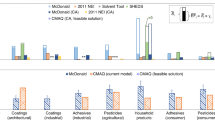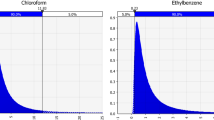Abstract
Background
Evidence suggests that clothing can influence human exposure to semi-volatile organic compounds (SVOCs) through transdermal uptake and inhalation.
Objectives
The objectives of this study were [1] to investigate the potential for clothing to function as a transport vector and secondary source of gas-phase SVOCs across indoor microenvironments, [2] to elucidate how clothing storage, wear, and laundering can influence the dynamics of transdermal uptake, and [3] to assess the potential for multiple human occupants to influence the multimedia dynamics of SVOCs indoors.
Methods
A computational modeling framework (ABICAM) was expanded, applied, and evaluated by simulating and augmenting two “real-world” chamber experiments. A primary strength of this framework was its representation of occupants and their clothing as unique entities with the potential for location changes.
Results
Estimates of transdermal uptake of diethyl phthalate (DEP) and di(n-butyl) phthalate (DnBP) were generally consistent with those extrapolated from measured concentrations of urinary metabolites, and those predicted by two other mechanistic models. ABICAM predicted that clean clothing (long sleeves, long pants, and socks, 100% cotton, 1 mm thick) readily accumulated DEP (6900−9700 μg) and DnBP (4500−4800 μg) from the surrounding chamber air over 6 h of exposure to average concentrations of 233 (DEP) and 114 (DnBP) μg·m-3. Because of their high capacity, clean clothing also effectively minimized transdermal uptake. In addition, ABICAM predicted that contaminated clothing functioned as a vector for transporting DEP and DnBP across indoor microenvironments and reemitted 13−80% (DEP) and 3−27% (DnBP) of the accumulated masses over 48 h.
Significance
Though the estimated secondary inhalation exposures from contaminated clothing were low compared to the corresponding primary exposures, these secondary exposures could be accentuated in other contexts, for example, involving longer timeframes of clothing storage, multiple occupants wearing contaminated clothing, and/or repeated instances of clothing-mediated transport of contaminants (e.g., from an occupational setting).
Impact
This modeling study reaffirms the effectiveness of clean clothing in reducing transdermal uptake of airborne SVOCs and conversely, that contaminated clothing could be a source of SVOC exposure via transdermal uptake and by acting as a vector for transporting those contaminants to other locations.
This is a preview of subscription content, access via your institution
Access options
Subscribe to this journal
Receive 6 print issues and online access
$259.00 per year
only $43.17 per issue
Buy this article
- Purchase on Springer Link
- Instant access to full article PDF
Prices may be subject to local taxes which are calculated during checkout





Similar content being viewed by others
Data availability
All model parameterization, associated equations, and descriptions, are included in this article and its supplementary information file.
References
Ren J, Tang M, Novoselac A. Experimental study to quantify airborne particle deposition onto and resuspension from clothing using a fluorescent-tracking method. Build Environ. 2021;209:108580.
Licina D, Nazaroff WW. Clothing as a transport vector for airborne particles: chamber study. Indoor Air. 2018;28:404–14.
McDonagh A, Byrne MA. The influence of human physical activity and contaminated clothing type on particle resuspension. J Environ Radioact. 2014;127:119–26.
McDonagh A, Byrne MA. A study of the size distribution of aerosol particles resuspended from clothing surfaces. J Aerosol Sci. 2014;75:94–103.
Kvasnicka J, Cohen Hubal EA, Siegel JA, Scott JA, Diamond ML. Modeling clothing as a vector for transporting airborne particles and pathogens across indoor microenvironments. Environ Sci Technol. 2022;56:5641–52.
Saini A, Okeme JO, Mark Parnis J, McQueen RH, Diamond ML. From air to clothing: characterizing the accumulation of semi-volatile organic compounds to fabrics in indoor environments. Indoor Air. 2017;27:631–41.
Saini A, Rauert C, Simpson MJ, Harrad S, Diamond ML. Characterizing the sorption of polybrominated diphenyl ethers (PBDEs) to cotton and polyester fabrics under controlled conditions. Sci Total Environ. 2016;563-4:99–107.
Kvasnicka J, Cohen Hubal EA, Rodgers TF, Diamond ML. Textile washing conveys SVOCs from indoors to outdoors: application and evaluation of a residential multimedia model. Environ Sci Technol. 2021;55:12517–27.
Saini A, Thaysen C, Jantunen L, McQueen RH, Diamond ML. From clothing to laundry water: investigating the fate of phthalates, brominated flame retardants, and organophosphate esters. Environ Sci Technol. 2016;50:9289–97.
Gong M, Weschler CJ, Zhang Y. Impact of clothing on dermal exposure to phthalates: observations and insights from sampling both skin and clothing. Environ Sci Technol. 2016;50:4350–7.
Morrison GC, Weschler CJ, Bekö G, Koch HM, Salthammer T, Schripp T, et al. Role of clothing in both accelerating and impeding dermal absorption of airborne SVOCs. J Expo Sci Environ Epidemiol. 2016;26:113.
Weschler CJ, Bekö G, Koch HM, Salthammer T, Schripp T, Toftum J, et al. Transdermal uptake of diethyl phthalate and di (n-butyl) phthalate directly from air: experimental verification. Env Health Perspect. 2015;123:928–34.
Sheu R, Stönner C, Ditto JC, Klüpfel T, Williams J, Gentner DR. Human transport of thirdhand tobacco smoke: a prominent source of hazardous air pollutants into indoor nonsmoking environments. Sci Adv. 2020;6:eaay4109.
Deziel NC, Friesen MC, Hoppin JA, Hines CJ, Thomas K, Freeman LEB. A review of nonoccupational pathways for pesticide exposure in women living in agricultural areas. Environ Health Perspect. 2015;123:515–24.
Gong M, Zhang Y, Weschler CJ. Predicting dermal absorption of gas-phase chemicals: transient model development, evaluation, and application. Indoor Air. 2014;24:292–306.
Morrison GC, Weschler CJ, Bekö G. Dermal uptake directly from air under transient conditions: advances in modeling and comparisons with experimental results for human subjects. Indoor Air. 2016;26:913–24.
Morrison GC, Weschler CJ, Bekö G. Dermal uptake of phthalates from clothing: comparison of model to human participant results. Indoor Air. 2017;27:642–9.
Cao J, Zhang X, Zhang Y. Predicting dermal exposure to gas-phase Semivolatile Organic Compounds (SVOCs): a further study of SVOC mass transfer between clothing and skin surface lipids. Environ Sci Technol. 2018;52:4676–83.
Kvasnicka J, Cohen Hubal E, Ladan J, Zhang X, Diamond ML. Transient multimedia model for investigating the influence of indoor human activities on exposure to SVOCs. Environ Sci Technol. 2020;54:10772–82.
Python Software Foundation. Python Software Foundation Website. [Internet]. [cited 2019 Sep 28]. Available from: https://www.python.org.
Guo Z. A framework for modelling non-steady-state concentrations of semivolatile organic compounds indoors–I: emissions from diffusional sources and sorption by interior surfaces. Indoor Built Environ. 2013;22:685–700.
Zhang X, Arnot JA, Wania F. Model for screening-level assessment of near-field human exposure to neutral organic chemicals released indoors. Environ Sci Technol. 2014;48:12312–9.
Mackay D. Multimedia environmental models: the fugacity approach. CRC press; 2001.
Rodgers TFM, Okeme JO, Parnis JM, Girdhari K, Bidleman TF, Wan Y, et al. Novel bayesian method to derive final adjusted values of physicochemical properties: application to 74 compounds. Environ Sci Technol. 2021; Available from: https://doi.org/10.1021/acs.est.1c01418.
Liu N, Cao J, Huang J, Zhang Y. Role of clothing in skin exposure to Di(n -butyl) Phthalate and Tris(1-chloro-2-propyl) phosphate: experimental observations via skin wipes. Environ Sci Technol Lett. 2021;8:270–5.
Lakey PS, Morrison GC, Won Y, Parry KM, von Domaros M, Tobias DJ, et al. The impact of clothing on ozone and squalene ozonolysis products in indoor environments. Commun Chem. 2019;2:56.
Gong M, Zhang Y, Weschler CJ. Measurement of phthalates in skin wipes: estimating exposure from dermal absorption. Environ Sci Technol. 2014;48:7428–35.
Bekö G, Morrison G, Weschler CJ, Koch HM, Pälmke C, Salthammer T, et al. Dermal uptake of nicotine from air and clothing: Experimental verification. Indoor Air. 2018 Mar;28:247–57.
Acknowledgements
The authors thank Prof. Glenn Morrison (UNC) for his feedback on the study and manuscript, John Ladan (U of T) for his feedback on the algorithm design, and Drs. Michael Breen and Hunter Fisher (U.S. EPA) for their technical reviews of the manuscript. Disclaimer: The views expressed in this article are those of the authors and do not necessarily represent the views or policies of the U.S. Environmental Protection Agency.
Funding
Funding was provided by the University of Toronto to support JK and the Natural Sciences and Engineering Research Council of Canada funding to MLD (NSERC, RGPIN-2017-06654).
Author information
Authors and Affiliations
Contributions
JK conceptualized the study, developed the modeling framework and simulations, and wrote the initial draft. MLD and EACH supervised the study, provided feedback, and edited the manuscript drafts.
Corresponding author
Ethics declarations
Competing interests
The authors declare no competing interests.
Additional information
Publisher’s note Springer Nature remains neutral with regard to jurisdictional claims in published maps and institutional affiliations.
Supplementary Information
Rights and permissions
Springer Nature or its licensor (e.g. a society or other partner) holds exclusive rights to this article under a publishing agreement with the author(s) or other rightsholder(s); author self-archiving of the accepted manuscript version of this article is solely governed by the terms of such publishing agreement and applicable law.
About this article
Cite this article
Kvasnicka, J., Cohen Hubal, E.A. & Diamond, M.L. Modeling clothing as a secondary source of exposure to SVOCs across indoor microenvironments. J Expo Sci Environ Epidemiol (2023). https://doi.org/10.1038/s41370-023-00621-2
Received:
Revised:
Accepted:
Published:
DOI: https://doi.org/10.1038/s41370-023-00621-2



